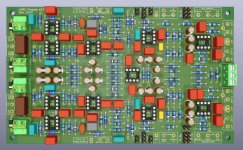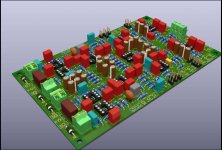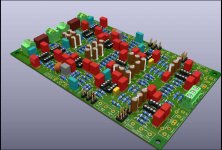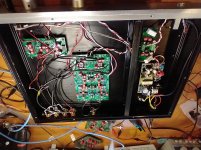he is answering the question asked in post #38 which is
Can you tell me what changes, when you decide to switch goals, from XXX to YYY ?
your request: "Why the change of devices" maybe could be explained, at least a little bit, by the switch of goals. Think it over and decide how you feel about that.
_
Can you tell me what changes, when you decide to switch goals, from XXX to YYY ?
your request: "Why the change of devices" maybe could be explained, at least a little bit, by the switch of goals. Think it over and decide how you feel about that.
_
Last edited:
Interesting. Can you enlighten us on why the change of devices?
Much simplified- the input noise consists of various components- a voltage noise component and a current noise component.
For source impedances in the order of 1kohm (resistance plus inductive impedance) and above, the low voltage noise bipolar input devices are noisier than higher voltage noise but lower current noise FET input devices. Hence the switch to FET input opamps.
MC cartridges have impedances generally << 1kohm, whereas MM cartridges are in the order of 1kohm and above. MM signal outputs are c. 20dB higher than MC.
The lower gain bandwidth product of the FET input opamps is not significant in the MM case as the closed loop gain of the input stage is c. 14dB less than the bipolar input device case, and the intrinsic distortion is lower/more benign than in the bipolar case because of the sort of square law nature of FETs vs the exponential nature of bipolar devices. Thus the input opamp satisfies minimum distortion, feedback factor and overload tolerance requirements.
Phono stages that are dual purpose MM/MC but use bipolar input opamps often have highly misleading S/N ratio specs when used with a MM cartridge as measurements are usually made with low impedance (20 ohms seems typical I believe) sources.
Last edited:
Mouser carts for the v2.0 boards.
Pin strips for adapters
Mouser Electronics
SMPS filter
Mouser Electronics
RIAA MM single specific parts
Mouser Electronics
RIAA MM parallel specific parts
Mouser Electronics
RIAA MC single specific parts
Mouser Electronics
RIAA MC parallel specific parts
https://www.mouser.com/ProjectManag...jectGUID=bd0ce5e8-f10e-4d43-a500-d2f1804f83dd
RIAA Common parts
https://www.mouser.com/ProjectManag...jectGUID=657da618-4f53-482d-9959-aa5992b8ab6f
I/O parts
https://www.mouser.com/ProjectManag...jectGUID=e104e74b-5a86-40c7-a96b-9891bc37ff63
Line-buffer parts
https://www.mouser.com/ProjectManag...jectGUID=18d257fd-9b8e-496f-ad41-f64b6d65c5ff
Warp Main board parts
https://www.mouser.com/ProjectManag...jectGUID=55D79F3B-C5C9-48A4-95FB-3FA59F420457
Pin strips for adapters
Mouser Electronics
SMPS filter
Mouser Electronics
RIAA MM single specific parts
Mouser Electronics
RIAA MM parallel specific parts
Mouser Electronics
RIAA MC single specific parts
Mouser Electronics
RIAA MC parallel specific parts
https://www.mouser.com/ProjectManag...jectGUID=bd0ce5e8-f10e-4d43-a500-d2f1804f83dd
RIAA Common parts
https://www.mouser.com/ProjectManag...jectGUID=657da618-4f53-482d-9959-aa5992b8ab6f
I/O parts
https://www.mouser.com/ProjectManag...jectGUID=e104e74b-5a86-40c7-a96b-9891bc37ff63
Line-buffer parts
https://www.mouser.com/ProjectManag...jectGUID=18d257fd-9b8e-496f-ad41-f64b6d65c5ff
Warp Main board parts
https://www.mouser.com/ProjectManag...jectGUID=55D79F3B-C5C9-48A4-95FB-3FA59F420457
Last edited:
I've observed over the years, that significantly more than (3/7ths) of the really great posts on diyAudio, are written on Friday, Saturday, and Sunday. I suppose there are huge numbers of members who don't read diyAudio except on the weekends, and that's when they type in their (excellent) comments.
I'm not saying this to belittle anything posted during the early part of the week; rather to encourage Wyn Palmer to wait till Monday before deciding whether he is disappointed with the responses he has received.
Still waiting, and yes, it is disappointing. I've had many more pertinent questions on AK. So it's either of minimal interest with the death of phono stages in general, old hat (although there are surprising subtleties) as it's yet another opamp phono stage, or too "obvious" (which I would assert it is not).
The power supply decoupling is a good illustration- it was simplified relative to the multi-stage LC filter/linear supply regulator that is so popular on AK- but it performs so much better.
Your comment on the resonance may not have hit the mark here- but it absolutely would have in the case of that popular design, which actually had amplification of the supply noise in important regions due to resonances in an obviously un-simulated design.
Still, the boards are in the US, and I'm not expecting any consequential issues, so they should be available for shipping within a week.
The v2.0 boards are here, and one has been assembled and tested successfully. The first batch was oversubscribed, as was the headphone amp, and I will order a second batch based on demand. The phono board set will be $30 excluding shipping/handling, while the headphone board will be $10 excluding shipping and handling. Both prices could fall if there is sufficient interest.
There have now been multiple users of the "warp filter" included on the board with a surprising level of enthusiasm for the result.
There have now been multiple users of the "warp filter" included on the board with a surprising level of enthusiasm for the result.
Still waiting, and yes, it is disappointing.
I think you have to take into account the very large number of phono projects posted on here with everything from highly detailed build instructions to gerber and bom and you are on your own. Almost every topology and technology is covered, including some that are fairly esoteric.
Just look at the group buys for phono stages in the relevant section.
I am indeed aware of this. I have assessed the other projects over a period of time, and that assessment is what, in part, led to the current project.
In a way, that was what suggested to me that a phono stage with this measured level of performance would at least create some curiosity and some questions/comments.
The corollary was that I was also reluctant to post this on DiyAudio for a number of reasons, including those implied by your observation, but I was persuaded, in main part, by AK members who frequent DiyAudio also.
The set of goals in the project were-
Create an easy to build phono/preamp based on state of the art commercial audio opamps with a measured performance that matched or exceeded essentially all of the commercial/DIY designs out there that also satisfied the known requirements of the psychoacoustic limits of global negative feedback stages, and was modular and extensible.
It was also intended to demonstrate that a commercially available, off the shelf, cheap, SMPS, could be employed with a degree of additional passive filtering to create a sufficiently noise free environment for that near state of the art measuring phono amplifier.
The design would meet exacting design criteria for distortion- hence the inclusion of the many tone tests and the focus on high order distortion products- and frequency response- in fact meeting RIAA compliance results where the ripple introduced by the ADC/DAC source/measurement system is a noticeable part of the measured result. It would also achieve essentially a maximum possible, constant over the audio frequency range, overload characteristic limited by the +/-15v supplies.
These criteria forced a particular architecture to be used.
In essence, it was intended to, in part, dissipate the illusions that often are associated with high end audio components.
In a way, that was what suggested to me that a phono stage with this measured level of performance would at least create some curiosity and some questions/comments.
The corollary was that I was also reluctant to post this on DiyAudio for a number of reasons, including those implied by your observation, but I was persuaded, in main part, by AK members who frequent DiyAudio also.
The set of goals in the project were-
Create an easy to build phono/preamp based on state of the art commercial audio opamps with a measured performance that matched or exceeded essentially all of the commercial/DIY designs out there that also satisfied the known requirements of the psychoacoustic limits of global negative feedback stages, and was modular and extensible.
It was also intended to demonstrate that a commercially available, off the shelf, cheap, SMPS, could be employed with a degree of additional passive filtering to create a sufficiently noise free environment for that near state of the art measuring phono amplifier.
The design would meet exacting design criteria for distortion- hence the inclusion of the many tone tests and the focus on high order distortion products- and frequency response- in fact meeting RIAA compliance results where the ripple introduced by the ADC/DAC source/measurement system is a noticeable part of the measured result. It would also achieve essentially a maximum possible, constant over the audio frequency range, overload characteristic limited by the +/-15v supplies.
These criteria forced a particular architecture to be used.
In essence, it was intended to, in part, dissipate the illusions that often are associated with high end audio components.
That's not a universal opinion, alas.
In any case, the board is stuffed, tested and incorporated into the preamp with the headphone etc. and it sounds quite good.
Initial testing shows no change in prior performance- except, as expected, the noise is a couple of dBs lower.
The VERY detailed build notes are on AK and are being updated even as I write this.
Once that is complete a link will be posted here.
In any case, the board is stuffed, tested and incorporated into the preamp with the headphone etc. and it sounds quite good.
Initial testing shows no change in prior performance- except, as expected, the noise is a couple of dBs lower.
The VERY detailed build notes are on AK and are being updated even as I write this.
Once that is complete a link will be posted here.
Attachments
Last edited:
It's not my design, as I had dismissed them for similar reasons, but Wayne Kirkwood did one for vinyl mastering. Getting the allpass right is the trick. If I build it fully I can select 300/150/75Hz roll off but its a lot of extra parts. On current rate of completion won't be until 2022 I get to start building it...
The first reports from builders are in as far as the single pole warp filter is concerned and they are surprisingly enthusiastic.
I find it a useful if not critical extension to the phono stage design, but others are reporting much more profound benefits on some of their records.
I joined Dropbox, and the build guides should be visible.
V1.3
Dropbox - Build Guide and Gain Calculator - Simplify your life
V2.0
Dropbox - LOMC v2 build options.pdf - Simplify your life v2 build options.pdf?dl=0
V1.3
Dropbox - Build Guide and Gain Calculator - Simplify your life
V2.0
Dropbox - LOMC v2 build options.pdf - Simplify your life v2 build options.pdf?dl=0
- Home
- Source & Line
- Analogue Source
- Ultra high spec opamp MC/MM phono, warp "elliptic" filter, line, headphone amps



